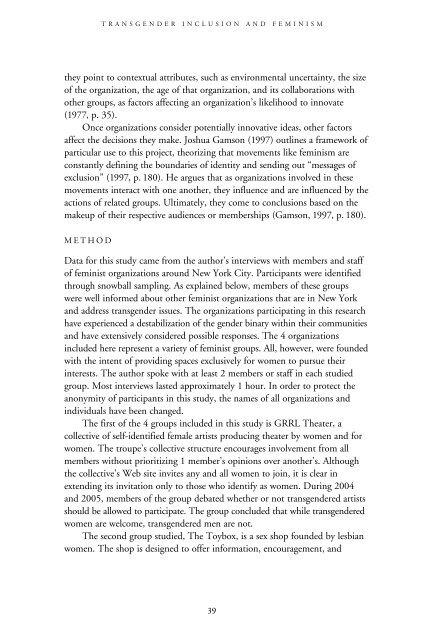2006 - School of Social Service Administration - University of Chicago
2006 - School of Social Service Administration - University of Chicago
2006 - School of Social Service Administration - University of Chicago
Create successful ePaper yourself
Turn your PDF publications into a flip-book with our unique Google optimized e-Paper software.
TRANSGENDER INCLUSION AND FEMINISM<br />
they point to contextual attributes, such as environmental uncertainty, the size<br />
<strong>of</strong> the organization, the age <strong>of</strong> that organization, and its collaborations with<br />
other groups, as factors affecting an organization’s likelihood to innovate<br />
(1977, p. 35).<br />
Once organizations consider potentially innovative ideas, other factors<br />
affect the decisions they make. Joshua Gamson (1997) outlines a framework <strong>of</strong><br />
particular use to this project, theorizing that movements like feminism are<br />
constantly defining the boundaries <strong>of</strong> identity and sending out “messages <strong>of</strong><br />
exclusion” (1997, p. 180). He argues that as organizations involved in these<br />
movements interact with one another, they influence and are influenced by the<br />
actions <strong>of</strong> related groups. Ultimately, they come to conclusions based on the<br />
makeup <strong>of</strong> their respective audiences or memberships (Gamson, 1997, p. 180).<br />
METHOD<br />
Data for this study came from the author’s interviews with members and staff<br />
<strong>of</strong> feminist organizations around New York City. Participants were identified<br />
through snowball sampling. As explained below, members <strong>of</strong> these groups<br />
were well informed about other feminist organizations that are in New York<br />
and address transgender issues. The organizations participating in this research<br />
have experienced a destabilization <strong>of</strong> the gender binary within their communities<br />
and have extensively considered possible responses. The 4 organizations<br />
included here represent a variety <strong>of</strong> feminist groups. All, however, were founded<br />
with the intent <strong>of</strong> providing spaces exclusively for women to pursue their<br />
interests. The author spoke with at least 2 members or staff in each studied<br />
group. Most interviews lasted approximately 1 hour. In order to protect the<br />
anonymity <strong>of</strong> participants in this study, the names <strong>of</strong> all organizations and<br />
individuals have been changed.<br />
The first <strong>of</strong> the 4 groups included in this study is GRRL Theater, a<br />
collective <strong>of</strong> self-identified female artists producing theater by women and for<br />
women. The troupe’s collective structure encourages involvement from all<br />
members without prioritizing 1 member’s opinions over another’s. Although<br />
the collective’s Web site invites any and all women to join, it is clear in<br />
extending its invitation only to those who identify as women. During 2004<br />
and 2005, members <strong>of</strong> the group debated whether or not transgendered artists<br />
should be allowed to participate. The group concluded that while transgendered<br />
women are welcome, transgendered men are not.<br />
The second group studied, The Toybox, is a sex shop founded by lesbian<br />
women. The shop is designed to <strong>of</strong>fer information, encouragement, and<br />
39
















